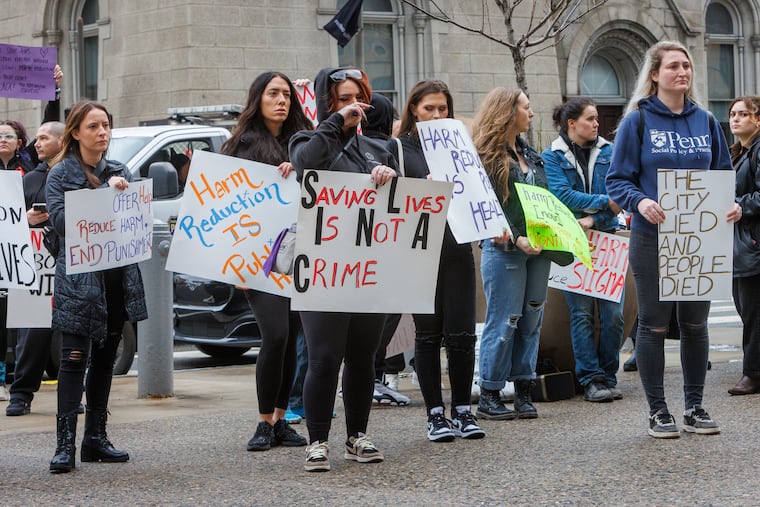Harm reduction must be part of efforts to end Kensington drug market | Editorial
These services have their fair share of critics within the neighborhood, but they help keep people alive who are struggling with addiction.

After years of neglect from city officials, Mayor Cherelle L. Parker is taking a more aggressive approach than her predecessors in addressing the open-air drug market in Kensington: In her first official act as mayor, she ordered police to use “any lawful means necessary” to abate what has become a civic catastrophe.
It is a long-overdue move from City Hall after a failed strategy that mired the neighborhood in homelessness, public drug use, and violence.
Parker has been unapologetic about making law enforcement a key part of her strategy, and few could credibly argue that policing should not play a role in the effort.
But the mayor would do well to recognize that harm reduction services that help protect people struggling with addiction until they’re ready for treatment can play a vital role in fixing what ails Kensington.
Parker’s recent moves, however, have left harm reduction providers feeling under siege when the mayor should be bringing them into the conversation about how to solve one of the city’s most intractable problems.
The Parker administration has said it will not allow any part of the $180 million coming to Philadelphia as part of a court settlement with opioid painkiller manufacturers to go to needle exchange programs. While the amount may be negligible — less than $40,000 in grants last year — the message is clear.
» READ MORE: Want to help Kensington? Start by listening to neighborhood voices. | Editorial
More immediately troubling is the removal of the harm reduction group known as Savage Sisters from its Kensington storefront. The small nonprofit — which distributes sterile syringes to prevent the spread of infection, provides showers and wound care, and helps connect people with treatment options — lost its lease after City Councilmember Quetzy Lozada interfered.
Critics say harm reduction providers attract and enable drug users. Lozada, who represents the 7th District, has said the group are “not good neighbors,” and also threatened funding for Prevention Point, a longtime needle exchange program on Kensington Avenue.
Lozada frames her decisions as supporting the wishes of her constituents, longtime residents of Kensington who are sick and tired of watching their children navigate around used needles and crumpled bodies on their way to school. Alongside her allies in the Kensington Caucus and the Parker administration, she is also pushing for “triage centers” to direct those suffering from addiction to treatment options, or in the case of refusal, incarceration.
All of this is meant to show a determination to do whatever it takes to eliminate the drug market. A goal that is, by itself, laudable.
What has happened in Kensington over the last decade, what former 7th District Councilmember Maria Quiñones Sánchez described as a “containment strategy,” was morally wrong. It never should have been the case that most of the burden for the city’s opioid epidemic should fall on the poorest residential community in Philadelphia.
No other community in the region, whether urban or suburban, allows people to engage in the rampant open-air drug usage that goes on 24/7 in Kensington. Restoring the basics of law and order is far from unreasonable.
» READ MORE: It’s going to take more than $20 million to help the people of Kensington | Editorial
More to the point, the old approach has an evident weakness: What happens when the chaos breaks containment? The city simply isn’t going to be able to find and process every drug user. The market will still exist and could spread to other neighborhoods if pushed out of Kensington. This could spark new turf wars, contributing to the gun violence epidemic. Without access to safe needles, those who continue using drugs despite the crackdown will be exposed to diseases like AIDS and hepatitis.
If Parker and the Kensington Caucus want to push the drug market out of Kensington, they need to identify spaces somewhere for harm reduction services to operate — with city support.
Parker has said that while she believes in harm reduction, she doesn’t support using city dollars to provide these services. If Prevention Point is unable to keep operating, and Savage Sisters is unable to find a new landlord, that may be a distinction without a difference.
These services have their fair share of critics within the neighborhood, but they also help keep people alive. If not in Kensington, then where? No one has yet provided an answer.
After a mass shooting in Northeast Philadelphia, Parker said the city needs an “all of the above” approach to gun violence. The opioid epidemic requires the same.